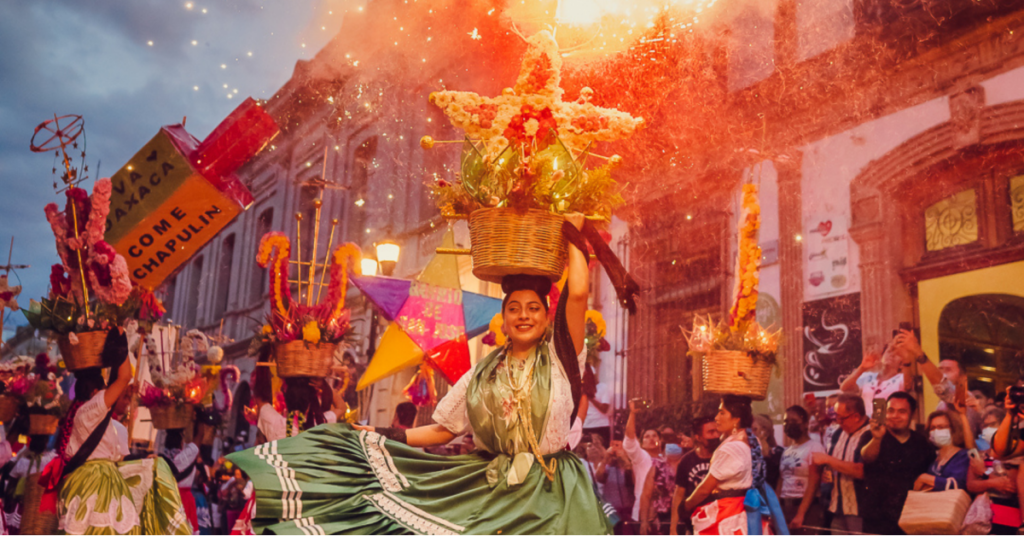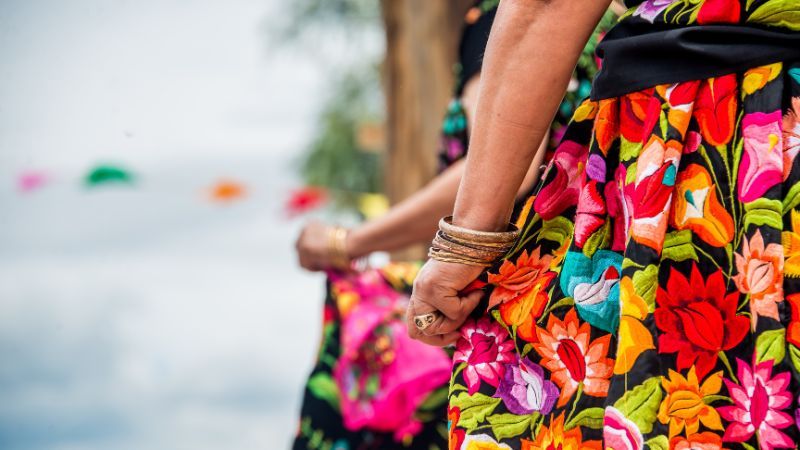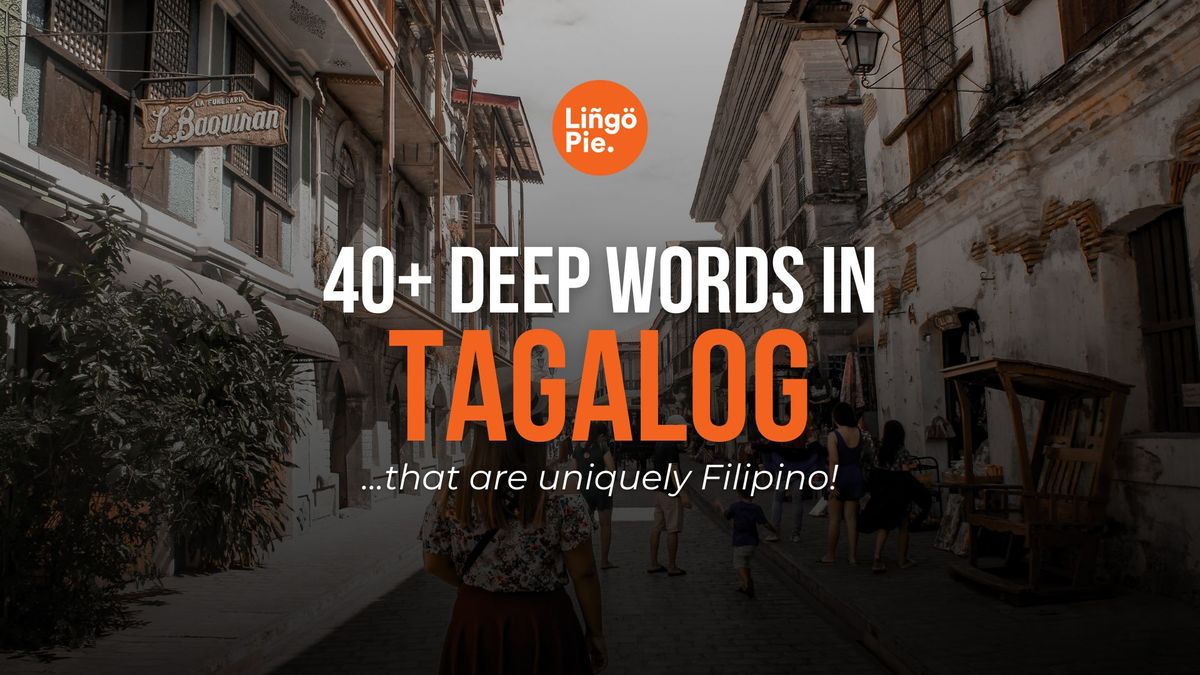Guelaguetza, also known as Los Lunes del Cerro (Mondays of the Hill), is one of Mexico's most vibrant festivals, held annually in Oaxaca to celebrate the region's diverse indigenous cultures through music, dance, and traditional costumes.
The festival, rooted in the Zapotec word for "offering" or "mutual help," highlights the importance of community and reciprocity. Guelaguetza is crucial for preserving and showcasing the rich heritage of Oaxaca's indigenous communities, attracting visitors worldwide, and fostering cultural appreciation.
In this blog post, we'll explore the festival's history, traditions, and key events, introduce essential Spanish words related to Guelaguetza, and offer practical tips for attendees.
Table of Contents
What Is Guelaguetza?
How Much Is The Entrance Fee For The Guelaguetza Festival?
When Does The Guelaguetza Festival Take Place?
When Is The Best Time To Visit Oaxaca For The Festival?
Traditions and Celebrations In Guelaguetza
How To Celebrate Guelaguetza?
Spanish Words and Phrases Related to Guelaguetza
Tips For Foreign Visitors
Final Words
FAQs
Learn Spanish by Watching Movies through Lingopie!
What Is Guelaguetza?

Guelaguetza, rooted in pre-Hispanic Zapotec and Mixtec traditions, began as a religious festival honoring the corn goddess Centeotl. Over time, it blended indigenous and Catholic customs. Today, it is a major cultural event in Oaxaca, emphasizing community, tradition, and mutual support.
The festival unites various indigenous groups, fostering cultural pride and boosting the local economy by attracting tourists. While it has evolved to include performances, parades, and exhibitions, Guelaguetza remains true to its original spirit of community and reciprocity.

How Much Is The Entrance Fee For The Guelaguetza Festival?
The entrance fee for the main Guelaguetza performances at the Guelaguetza Auditorium (Auditorio Guelaguetza) varies depending on the seating section. Prices can range from around $10 to $40 USD per ticket.
However, there are also many free events and activities associated with the festival throughout Oaxaca, including parades, music performances, and cultural exhibitions.
When Does The Guelaguetza Festival Take Place?
The Guelaguetza festival is celebrated annually in Oaxaca, Mexico, on the last two Mondays of July, known as "Los Lunes del Cerro" (Mondays of the Hill).
In addition to these main days, various related events and activities take place in the weeks leading up to and following these dates, making the entire month of July a vibrant time for cultural festivities in Oaxaca.
When Is The Best Time To Visit Oaxaca For The Festival?
Guelaguetza takes place in July, with the main events typically occurring on the last two Mondays of the month, known as "Los Lunes del Cerro." Plan to arrive a few days early to enjoy the pre-festival activities and secure good accommodation.
Read Also:

Traditions and Celebrations In Guelaguetza

Guelaguetza is packed with vibrant events, including parades, dance performances, and cultural exhibitions. These events showcase the rich traditions of Oaxaca's indigenous communities, drawing visitors from around the world.
Traditional Dances
Traditional dances are the heart of Guelaguetza, each telling unique stories and representing different aspects of indigenous culture.
Danza de la Pluma: This dance reenacts the Spanish conquest from the indigenous perspective, featuring elaborate feathered headdresses and symbolic choreography.
Danza de los Diablos: Originating from the Mixtec region, this dance uses devil masks and dramatic movements to depict the struggle between good and evil.
Flor de Piña: Celebrating the pineapple harvest, this dance highlights the joy and abundance of rural life, performed by women in colorful traditional costumes.
Music in the Festival
Music plays a crucial role in Guelaguetza, enhancing the atmosphere and complementing the dances.
Types of Instruments Used: Traditional instruments like the marimba, drums, and flutes are commonly used, each adding a distinctive sound to the performances.
Popular Songs and Their Significance: Songs like "La Sandunga" and "Dios Nunca Muere" are beloved anthems of the festival, embodying the spirit and cultural heritage of Oaxaca.
How To Celebrate Guelaguetza?
Celebrating Guelaguetza involves immersing yourself in the vibrant culture and traditions of Oaxaca. Here are some ways to celebrate this festive occasion:
Attend the Festival: Join locals and visitors at the Guelaguetza Auditorium to witness traditional dances, music performances, and cultural exhibitions.
Explore Local Cuisine: Indulge in Oaxacan delicacies such as mole, tlayudas, and chapulines from street vendors and local restaurants.
Engage in Community Activities: Participate in parades, processions, and other community events that highlight Oaxaca's cultural heritage.
Visit Artisan Markets: Browse and purchase handicrafts, textiles, and pottery made by local artisans, supporting traditional craftsmanship.
Learn Spanish Phrases: Familiarize yourself with basic Spanish phrases to communicate with locals and deepen your cultural immersion.
Experience Local Attractions: Take time to visit nearby attractions like Monte Albán, Hierve el Agua, and artisan villages to further explore Oaxaca's history and landscapes.
Respect Traditions: Show respect for local customs and traditions, such as dress codes during performances and etiquette when visiting sacred sites.
Spanish Words and Phrases Related to Guelaguetza

Understanding key Spanish words and phrases enriches your appreciation of Guelaguetza, allowing you to connect more deeply with its traditions and cultural significance.
- Guelaguetza: Originating from the Zapotec word for "offering" or "mutual help," it signifies the spirit of giving and community central to the festival.
- Comparsa: A parade or procession featuring traditional music, dance, and costumes, essential to the festive atmosphere.
- Calenda: A traditional parade that kicks off the festival, marked by fireworks, music, and dancing in the streets.
- Tequio: A form of communal work and cooperation, highlighting the collective effort and support within communities.
- Danza: Refers to the various traditional dances performed during Guelaguetza, such as Danza de la Pluma, Danza de los Diablos, and Flor de Piña.
- Traje típico: Traditional costumes worn by performers, reflecting the cultural heritage and identity of different indigenous groups.
- Artesanía: Handicrafts that play a significant role in the festival, showcasing local artisans' skills and cultural expressions.
- Comida típica: Traditional foods enjoyed during Guelaguetza, adding to the cultural richness of the celebration.
- Mole: A rich, complex sauce made from various ingredients, often served with meat.
- Tlayudas: Large, crispy tortillas topped with beans, cheese, and other toppings.
- Chapulines: Roasted grasshoppers, a traditional and protein-rich snack.
Read Also:

Tips For Foreign Visitors
Places to Stay
- Hotels: Book early to secure a room in popular hotels like Quinta Real Oaxaca, Hotel Los Amantes, or Parador de Alcalá.
- Budget Options: Consider hostels or budget hotels like Hostal de las Américas or Casa Angel Youth Hostel.
- Local Experience: Opt for a stay in a traditional bed and breakfast or an Airbnb in the city center to immerse yourself in local culture.
What to Wear and Bring
- Clothing: Wear comfortable, breathable clothing suitable for hot weather. Light, loose-fitting attire and comfortable walking shoes are ideal.
- Accessories: Bring a hat, sunglasses, and sunscreen to protect against the sun. Carry a reusable water bottle to stay hydrated.
- Essentials: Pack a small bag for essentials like a camera, a map, and some cash, as not all vendors accept cards.
How to Immerse Yourself in the Local Culture
- Learn Basic Spanish: Familiarize yourself with common Spanish phrases to communicate more easily with locals.
- Engage with Locals: Participate in community activities, visit local markets, and try traditional foods.
- Explore Beyond the Festival: Take time to visit nearby attractions like Monte Albán, Hierve el Agua, and local artisan villages.
Etiquette and Respect for Traditions
- Be Respectful: Show respect for local customs and traditions. Ask for permission before taking photos of people.
- Participate Thoughtfully: Join in the festivities with enthusiasm but be mindful of your behavior, especially during religious or solemn events.
- Support Local Economy: Buy from local artisans and vendors to support the community and take home unique souvenirs.
Final Words
Guelaguetza is more than just a festival; it's a vibrant celebration of Oaxaca's diverse cultural roots. From ancient rituals to modern-day festivities, it brings together communities in a spirit of unity and pride.
Whether you're planning to attend or simply curious, Guelaguetza invites everyone to experience the music, dance, flavors, and hospitality that define Oaxacan culture. It's an opportunity to celebrate, learn, and create lasting memories in the heart of Mexico!
Frequently Asked Questions
1. What is the biggest festival in Oaxaca?
The biggest festival in Oaxaca is Guelaguetza, also known as Los Lunes del Cerro (Mondays on the Hill). It celebrates the diverse indigenous cultures of Oaxaca through music, dance, and traditional arts.
2. What happens at Guelaguetza?
At Guelaguetza, you can expect to see colorful dance performances, hear traditional music, and enjoy local cuisine. It's a festive gathering where indigenous communities showcase their cultural heritage.
3. Who participates in Guelaguetza?
Guelaguetza is participated in by various indigenous groups from Oaxaca, including the Zapotec, Mixtec, and Mazatec peoples. They come together to perform traditional dances, wear elaborate costumes, and share their customs with visitors.
4. What does the word Guelaguetza mean in Zapotec?
In Zapotec, Guelaguetza means "offering" or "reciprocal exchange of gifts and services." It embodies the spirit of mutual aid and cooperation within communities, which is central to the festival's cultural significance.
Learn Spanish by Watching Movies through Lingopie!
Who says learning Spanish can’t be fun? Grab your favorite snacks and binge-watch Spanish TV shows and movies to learn Spanish. That's the mission of Lingopie, making language learning fun and immersive!
Lingopie makes learning a new language fun and effective by using real TV shows, movies, and documentaries. It offers interactive subtitles, so you can click on any word to get an instant translation and pronunciation. If this sounds fun to you, download Lingopie from the App Store or Play Store now and get a FREE 7-day trial!







![30+ Modern English Slang Terms For Money [Guide]](/blog/content/images/size/w300/2025/06/Slang-term-for-money.jpg)
![5 Official Spanish Language Tests To Show Your Proficiency Level [Guide]](/blog/content/images/size/w300/2025/06/Spanish-Language-Tests.jpg)

![Why Memorizing Spanish Words Won’t Make You Fluent [Tips]](/blog/content/images/size/w300/2025/06/how-to-practice-spanish-vocabulary.jpg)